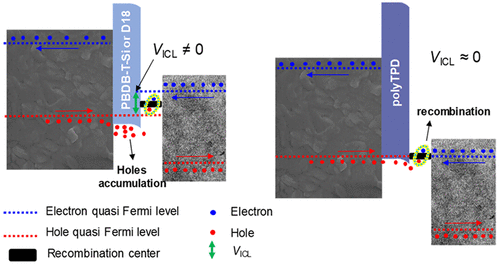当前位置:
X-MOL 学术
›
Nano Lett.
›
论文详情
Our official English website, www.x-mol.net, welcomes your
feedback! (Note: you will need to create a separate account there.)
Tuning of the Interconnecting Layer for Monolithic Perovskite/Organic Tandem Solar Cells with Record Efficiency Exceeding 21%
Nano Letters ( IF 9.6 ) Pub Date : 2021-09-10 , DOI: 10.1021/acs.nanolett.1c02897 Pang Wang 1, 2 , Wei Li 3 , Oskar J Sandberg 3 , Chuanhang Guo 1, 2 , Rui Sun 4 , Hui Wang 1, 2 , Donghui Li 1, 2 , Huijun Zhang 1, 2 , Shili Cheng 1, 2 , Dan Liu 1, 2 , Jie Min 4 , Ardalan Armin 3 , Tao Wang 1, 2
Nano Letters ( IF 9.6 ) Pub Date : 2021-09-10 , DOI: 10.1021/acs.nanolett.1c02897 Pang Wang 1, 2 , Wei Li 3 , Oskar J Sandberg 3 , Chuanhang Guo 1, 2 , Rui Sun 4 , Hui Wang 1, 2 , Donghui Li 1, 2 , Huijun Zhang 1, 2 , Shili Cheng 1, 2 , Dan Liu 1, 2 , Jie Min 4 , Ardalan Armin 3 , Tao Wang 1, 2
Affiliation

|
The photovoltaic performance of inorganic perovskite solar cells (PSCs) still lags behind the organic–inorganic hybrid PSCs due to limited light absorption of wide bandgap CsPbI3-xBrx under solar illumination. Constructing tandem devices with organic solar cells can effectively extend light absorption toward the long-wavelength region and reduce radiative photovoltage loss. Herein, we utilize wide-bandgap CsPbI2Br semiconductor and narrow-bandgap PM6:Y6-BO blend to fabricate perovskite/organic tandem solar cells with an efficiency of 21.1% and a very small tandem open-circuit voltage loss of 0.06 V. We demonstrate that the hole transport material of the interconnecting layers plays a critical role in determining efficiency, with polyTPD being superior to PBDB-T-Si and D18 due to its low parasitic absorption, sufficient hole mobility and quasi-Ohmic contact to suppress charge accumulation and voltage loss within the tandem device. These perovskite/organic tandem devices also display superior storage, thermal and ultraviolet stabilities.
中文翻译:

调整单片钙钛矿/有机串联太阳能电池互连层的效率超过 21%
由于宽禁带 CsPbI 3-x Br x在太阳光下的光吸收有限,无机钙钛矿太阳能电池 (PSC) 的光伏性能仍落后于有机-无机杂化 PSC 。用有机太阳能电池构建串联器件可以有效地将光吸收扩展到长波长区域并减少辐射光电压损失。在此,我们利用宽带隙 CsPbI 2Br 半导体和窄带隙 PM6:Y6-BO 混合制造钙钛矿/有机串联太阳能电池,效率为 21.1%,串联开路电压损失非常小,为 0.06 V。我们证明了互连的空穴传输材料层在决定效率方面起着关键作用,polyTPD 优于 PBDB-T-Si 和 D18,因为它具有低寄生吸收、足够的空穴迁移率和准欧姆接触,以抑制串联器件内的电荷积累和电压损失。这些钙钛矿/有机串联器件还显示出卓越的存储、热和紫外线稳定性。
更新日期:2021-09-22
中文翻译:

调整单片钙钛矿/有机串联太阳能电池互连层的效率超过 21%
由于宽禁带 CsPbI 3-x Br x在太阳光下的光吸收有限,无机钙钛矿太阳能电池 (PSC) 的光伏性能仍落后于有机-无机杂化 PSC 。用有机太阳能电池构建串联器件可以有效地将光吸收扩展到长波长区域并减少辐射光电压损失。在此,我们利用宽带隙 CsPbI 2Br 半导体和窄带隙 PM6:Y6-BO 混合制造钙钛矿/有机串联太阳能电池,效率为 21.1%,串联开路电压损失非常小,为 0.06 V。我们证明了互连的空穴传输材料层在决定效率方面起着关键作用,polyTPD 优于 PBDB-T-Si 和 D18,因为它具有低寄生吸收、足够的空穴迁移率和准欧姆接触,以抑制串联器件内的电荷积累和电压损失。这些钙钛矿/有机串联器件还显示出卓越的存储、热和紫外线稳定性。











































 京公网安备 11010802027423号
京公网安备 11010802027423号